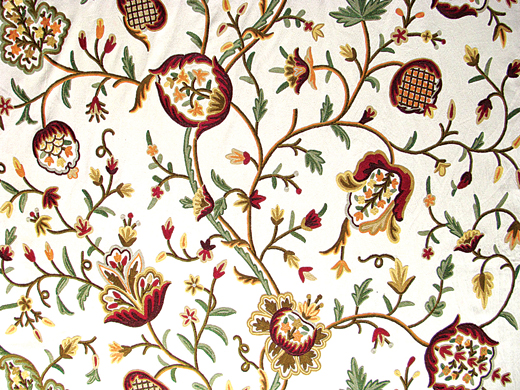These can be found in posh designer stores throughout the world. The unique Crewel work by master artisans is an identity of families and clans across Kashmir, a Kashmir Life report.

One indigenous craft that defies the practice adopted world over is crewel work, commonly used for drapery and upholstery. The trademark secret of this art lies in a small tool called aare. This steel needle has a notch at its base, and is added with a wooden handle on the top to pull yarn that is fed by the craftsman from beneath the cloth. Crewel work is locally called Jalakdozi. It is different from needlework practiced in other regions where a simple needle fed with a thread is used to form different embroidery patterns over a piece of cloth.
The Jalakdooz, a craftsman usually using his aare from the top of the cloth, forms small loops of thread emerging from below to form a pattern of chain formations, also referred to as chain stitch craft. Workers say that the aare covers more surface in less time than what a needle can achieve. However, mastering this craft of linking the yarn comes with experience.
It is this linking of yarn that later embosses over a cloth giving it more strength. The workers take special care in blending the colors and shading the flowers and leaves to make them look natural in the finished products.
Yamin Ahmad Alakaband is the fourth generation of his family to take up the yarn business at his ancestral shop at Zainakadal, supplying yarn of varying thickness and shades to the local craftsman. Ahmad says that the tradition of using yarn for embroidery is rooted in the craft of Gabba and Namda where craftsman used to make embroidery using woolen yarn to make different designs. Later the craft refined as Crewel or chain stitch embroidery was done on thick material, mostly cotton, and it became an instant hit for furnishing and upholstery; and usually carried floral and creeper designs.
The base material is usually 1.5 yards in width and craftsman work on running yard lengths, creating a similar design to make drapery.
Haji Gulzar Ahmad Teng is one of the major exporters of chain stitch and crewel in Kashmir. He says it was because craftsmen upgraded a traditional skill, that Kashmir was able to make a name for itself in the crewel and chain stitch in world market. Teng’s main workforce is based in south Kashmir where women have a mastery over the skill.
The sizes can start from small decorative rugs to very large sized ones but the popular ones come in a size of 1 yard x 1.5 yard and a single piece of this fully embroidered piece can take a worker up to 20 days to make. A prayer rug or Jainamaz is also on the manufacturing list and is mostly imported to Middle Eastern countries.
For the craftsman, the task begins with the selection of a base cloth that is usually white or cream in color. A designer called Naqishgir or Naqashband has the assigned task to trace a design usually using a printed block or a perforated sheet that are laid over the cloth with charcoal powder spread over it to get the design underneath the sheet, that is later outlined using a special pen and ink.
The design elements range from flora and fauna patterns mostly influenced by nature, in addition to scenes from battles and hunting. Geometric designs too are in vogue. Some of the earlier designs are called Theridar, Badamdar, Guldar and Bulbuldar. The embroidery work has to be carried out according to the color scheme that has to be followed by using specially dyed yarn. In past, the yarn was mostly single ply wool, but today art silk of two-ply thickness is used for the embroidery. Initially, a craftsman draws the outline of the designs with the yarn, and then works to cover the entire cloth with embroidery. In the end, the product goes for washing, before a specialized set of workers cut any long threads left during the embroidery process. Traditionally, men were the main artisans who dominated the craft, but over time women are making their mark in this field.













